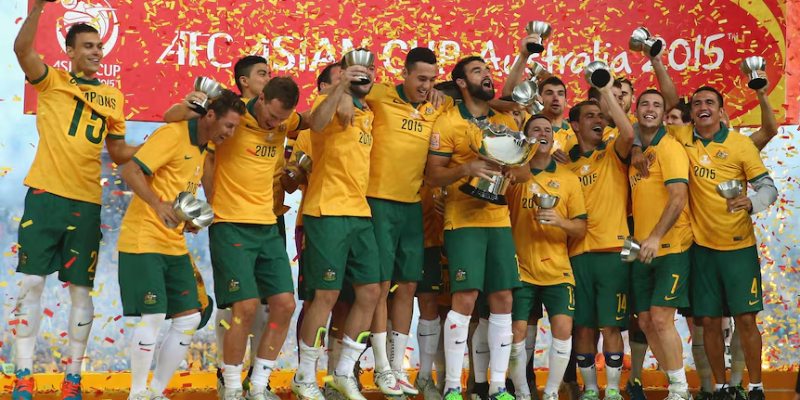Right, the question “why are Australia in the Asian Cup?” sounds like a mismatch—after all, Australia is in Oceania, right? But the truth is, since 2006 Australia switched confederations, leaving the Oceanic Football Confederation (OFC) and joining the Asian Football Confederation (AFC). Because of that move, the Socceroos now compete in the AFC Asian Cup like Japan, South Korea, Iran, Saudi Arabia and the rest.
Below, CandyGoal will walk you through the history, reasons, effects, and what this means in practice for Australia in Asian international competition.
The history of Australia’s switch to Asia

When Australia first entered international football, they were a founding member of the OFC. But over decades the Football Federation in Australia grew increasingly frustrated by several issues:
- Dominance: Australia often crushed their OFC rivals by large margins, which reduced meaningful competition. This meant many games were predictable and offered little preparation for top-tier international play.
- Qualification hurdles: Although OFC teams had paths to the World Cup, they almost always had to go through inter-confederation play-offs, meaning even if Australia won the OFC zone, they still needed to beat a team.
- Desire for growth: Stronger opponents, better tournaments, improved exposure, more commercial opportunities (TV, sponsorship, fan engagement) — all these were limited under OFC. Moving to the AFC promised more regular high-level matches, which would push up standards.
These frustrations led to a formal application. In 2005, Australia notified OFC of its intention to move, AFC approved the invitation, and FIFA gave its backing. On 1 January 2006, Australia officially became a full member of the AFC.
Key reasons Australia moved from OFC to AFC

Here are the primary drivers behind Australia’s decision:
- More consistent competition – In Asia, Australia would face several strong teams regularly (Japan, South Korea, Iran, etc.), rather than having to wait for rare inter-confederation playoffs.
- Better World Cup qualification chances – Under OFC, even winning the zone didn’t guarantee a World Cup spot. In AFC, there are more qualification spots, and no need for an extra playoff in many cases.
- Player development & visibility – Playing stronger opposition helps grow the national team and youth players. Also, clubs and players get more exposure in regional competitions (e.g. AFC Champions League).
- Commercial and infrastructural growth – More fans, bigger broadcast deals, better tournaments, and greater organisational investment. Countries in Asia have large markets, so there’s more opportunity.
What changed after joining AFC

Once Australia became part of AFC, several things shifted:
- Australia started entering the AFC Asian Cup tournaments instead of only OFC competitions.
- They won the Asian Cup in 2015, when the tournament was hosted in Australia — a major milestone showing the benefits of tougher competition.
- Regular matches against stronger Asian teams improved competitiveness. The national team was more battle-hardened.
- There was greater commercial interest, media coverage, and infrastructural development (stadiums, youth systems, etc.).
Addressing the geography objection
Some fans argue that Australia is not part of continental Asia. That’s true in the strict geographical sense. But in the world of football:
- Confederation membership isn’t always strictly geographical. It’s also about footballing logic, competitiveness, political and organisational practicalities. FIFA allows nations to shift confederations under certain conditions.
- Oceania (outside New Zealand) has many small island nations with limited resources and infrastructure. For Australia, being in OFC meant many lopsided matches and long travel for little gain. Joining AFC meant more competitive balance.
Impacts for Australia and for Asia
The move has ramifications both for Australia and for the AFC region:
- For Australia: More consistent exposure to strong opponents, improved performance in World Cup qualifers, raised profile in Asian club competitions, boosted domestic interest in the game.
- For Asia (AFC): Gained a strong team that increases competitiveness, raises standards, and adds value in terms of broadcasting, tournaments, and sponsorship. Also, Asian football becomes more widely followed when big nations like Australia are in the mix.
- For OFC: Australia’s departure gave other Oceania teams more chances to shine, but also left OFC weaker in terms of high-ranking, competitive teams.
Current status & statistics
Here are some facts showing where Australia stands now:
- Australia has participated in each AFC Asian Cup since joining. Their first was in 2007.
- They won the tournament in 2015 on home soil. That remains their only title in the Asian Cup so far.
- They qualified for the upcoming 2027 Asian Cup in Saudi Arabia.
Conclusion
In short, why are Australia in the Asian Cup comes down to ambition, opportunity, and fairness. By moving.
If you’re curious about how this has shaped specific players, match-records, or Australia’s upcoming fixtures in the Asian Cup, CandyGoal can dive into those too. Want a breakdown of Australia’s best moments in the Asian Cup or how their performance stacks up vs. Asian giants? Let me know!






